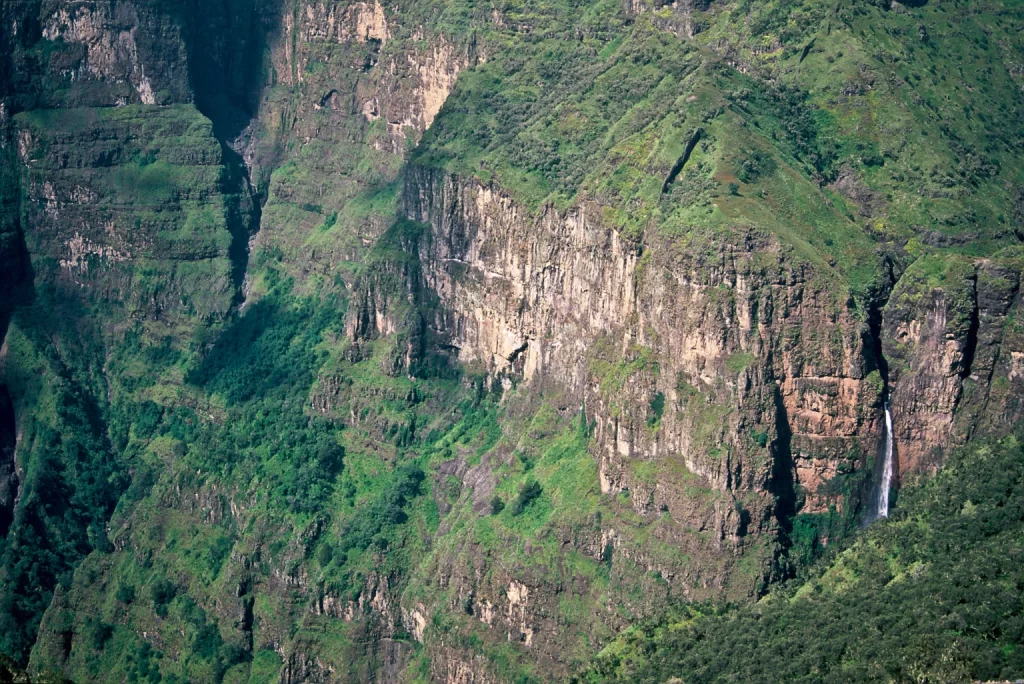Back before the 17-month Ethiopian civil war halted tourism and scared off travellers, Don Pinnock took the long, hard road to the Simien Mountains. Up there, he recalls, lammergeiers rule the ramparts and gelada monkeys bare their hearts.
My eyes registered the gradient as gentle but, after 35 kilometres at around 3,500 metres above sea level, my legs calibrated each step in degrees of pain.
The deeply grooved pony track led up through giant lobelia and huge Erica trees towards a sky which swirled and rumbled, threatening rain. I found myself chanting my usual mountain mantra: “Why, why, why do I do this?” It was 2007, and my goal was Imet Gogo (The Mother), a lofty eyrie on the rim of the Great Rift Valley in northwestern Ethiopia — but that was still a long way ahead.

“Eggs?” he said, hopefully. When I failed to respond the other one tried another tack: “Hellowhat’syournamedoyouhavepenforme?”
“What?” I croaked at him, then realised it was a heavily accented version of a standard local greeting to foreigners. But I was too far gone to be polite: “Look,” I replied, knowing he wouldn’t understand a word I said. “I’ve just walked all day through these crazy mountains of yours. Two of my party are back there in that Erica forest suffering from exhaustion and altitude sickness. Now you want me to give you a pen and buy your damn eggs.”
The two looked at me round-eyed, obviously impressed by my speech. Then, simultaneously, they said: “ishee,” (cool) and continued dogging my steps up to Gich Camp. It was, I grumbled to myself, one of those situations in which the idea of hiking the Simiens had been too thrilling to allow better judgement to prevail — and now it was too late to pull out.

Earlier that day a fellow traveller had done the sensible thing. When a Toyota Land Cruiser had appeared magically at Sankarber, he negotiated a price with the driver and slung his pack in the back. His face, as the sturdy vehicle headed back to Gondar, looked both disappointed and relieved.
I should have heeded the warning signals back at the village of Debark. In Amharic, its name means, appropriately, ‘not fair’. It certainly wasn’t. It seemed to be filled with offerings for loans — at hugely inflated prices — dirty camping mattresses, used maps of the Simien Mountains and lifts to Sankaber at costs that would make a banker weep.
We had trudged up through the village’s marketplace ahead of the pack-mules, hoping to escape the incessant peddling of kit and services. Apart from some corrugated iron roofs, the place could have been in any century. Hundreds of hopefuls, strewn all about, purveyed richly-coloured cloth, startlingly red peppers, huddled sheep, bolts of bright cloth, Ge’ez Bibles, beads and an impossible assortment of junk I couldn’t imagine anyone buying.
After hours of slogging through fields and dongas, we had pitched camp at Mindigebsa in a downpour. “It never rains in Ethiopia in October,” our guide, Bedassa Jote, had insisted, looking offended as he coaxed a flame out of the Primus while a drenched mule-minder held an umbrella over him. He soon produced strong, hot tea followed by pasta and a fresh tomato and garlic sauce which we had gulped down thankfully before retiring to bed at 19h30.
Heading for the top
The trip to Sankaber the next day was peasant-picturesque but hadn’t looked like the national park it was: more like a non-stop tableaux of Old Testament-robed people riding donkeys, shepherding sheep or ploughing steep hillsides with oxen and ploughs.
The Simiens had made themselves felt at the Lamma River, where the path led up and up to a higher plateau. Sankaber had been nothing to write home about — a few huts and a wall-less roof for visitors to shelter under.
From there a road had swept us three remaining travellers plus guide, loaded mules, mule minders and an AK47-toting warden down into a natural meadow which formed the head of a yawning valley offering tantalising glimpses of vast valleys.
But at that altitude, the day’s hike had been too long and taxing for us. Two fellow hikers had sat down suddenly somewhere on an endless slope and I guessed it to be altitude sickness: I hoped it wasn’t worse. All that was left of hikers was me and my aching legs — and now my companions were two kids trying to sell eggs. If someone got really ill or injured, help was one hell of a long way off.
The mules had gone ahead to Gich Camp, the last overnight stop before I met Gogo, and the little blue tents, when they appeared over a rise, looked like the Addis Hilton. Two mules were quickly dispatched to save the weary hikers and, after a rehydration process and a mug of whiskey, the insanity of being here subsided a little. A bright Venus dragged the Milky Way into view, the fire made our sodden boots steam and rice alfresco and roasted maize appeared.
“Not bad,” I thought, but my mind refused to entirely justify being perched on a flea-infested saddle blanket 3,500 metres above sea level. This was a big, wild, hard country and we weren’t at the top yet.
The party thins
The next morning our party was reduced to two, plus guide, muleteer and warder. The trail led up through forests of giant lobelias with strange flowering heads soaring to eight metres above their aloe-like leaves.
After about an hour and a half of steady uphill, our peripheral views seemed to narrow — as they sometimes do on high mountains. As we walked out onto Imet Gogo’s rocky shoulder the trail vanished into nothingness and silence.
To the south, a massive gorge, with sheer cliff walls higher than Table Mountain, sliced our peninsula from the next finger on which we could see the tiny huts of Chennek Camp. In the gorge waterfalls plunged like silent lace, funnelling water into a tracery of streams and rivers two kilometres below us.
Further south, another finger probed the abyss: Bwahit, at 4,430m the second-highest peak in the Simiens. Below us, to the east and north as far as the eye could see, was ‘Dib Bahir Woreda’, the Sea of Mountains.
I sat down suddenly, tears welling, such was the raw beauty which lay just beyond my boots. The empty silence was broken by the hiss of wind over feathers and a huge lammergeier, catching an updraft, glided metres above our heads.
It was so close I could see its golden eyes and the subtle adjustments of its primary feathers. Far below a rare walia ibex with massive horns hugged the base of a precipitous cliff.
I found myself chanting my other mountain mantra: “Yes, yes, yes. . . .”
Lion monkeys
We plodded down from Imet Gogo in a triumphal procession consisting of several hundred gelada ‘lion monkeys’. These large, bewhiskered primates also known as bleeding-heart baboons because of a red, heart-shaped piece of exposed skin on their chests — were communicating in sounds so close to human speech it was eerie. They were unafraid of us or our horse as they rooted and chatted, merely turning their backs on us to indicate displeasure if we approached too closely.
The males of this species, once widespread throughout Africa, really do look like lions and, when they bare their teeth, are a fearsome sight.
The two-day return trip to Debark was exhilarating — our legs had been toned up by the upward trip, our lungs acclimatised to the altitude and the trail was mostly downhill. Also, somehow, you notice more going downhill — possibly because the landscape is below the level of your gaze and not above it.
The mountain flora was strangely familiar: it’s basically giant fynbos. Evidently many of the plants which now constitute the Cape Floral Kingdom began in these highlands and, over millions of years, migrated down the Rift Valley mountains and the Drakensberg chain until they could go no further south.
As good travellers should, they reduced their bulk along the way, but in the Simiens, forests of Erica trees jostle with giant geraniums and everlastings. St John’s wort also started out from the Ethiopian highlands but only got as far south as Mpumalanga, where its common name is curry bush.
There were few birds at these altitudes, but the valleys rang with the deep-throated ha de haa of the endemic wattled ibis — this species has a gravely call which makes hadedas (which are also found in Ethiopia) sound like hysterical schoolgirls. And whenever we ate we were seldom without an attendant cluster of thick-billed ravens. They thumped down heavily, almost within arms reach, their huge, wicked-looking beaks keeping us on the alert.
As we descended, agricultural cultivation brought a marked change in the scenery. It was difficult to believe that people ever starved in Ethiopia. All about were fields of teff, a grain used to make injera, a kind of pancake and the country’s staple food. Between them were tracts of wheat and beans.
Rivers flowed strongly down the many valleys and plunged thunderously over waterfalls. Although the east and northeast of the country are arid — that’s where the Tigrayans are waging war today and maybe why — the bounty around us seemed capable of feeding the nation for years.
I’d hazard a guess that two things blocked this: there are no roads to get the produce out and farmers, who constitute most of the population, are notoriously difficult people from whom to extract a surplus.
As we trekked down the road out of the mountains, a beautiful little girl with tight braids fell into step with me. I estimated her age at about six. She looked up at me shyly, her large eyes twinkling above the fold of her cloak, and began the standard greeting: “Hellowhat’syournamehaveyougotpenforme?
I dug in the bottom of my camera bag and produced an old Bic. She clutched it with both hands and gave a little hop-skip of delight.
“Ishee, ishee. . . .”
The author Don Pinnock made the journey to the Siemen Mountains back in 2007; this is his reminiscing of the hike. The story was published in May 2022 and has since been edited slightly.
Source/Credit: www.dailymaverick.co.za









